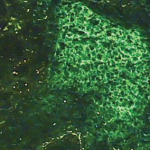Out of 3,514 patients enrolled in the SICCA registry by September 2013, 3,310 eligible patients were identified, and 771 of these presented for follow-up. Among patients who were found to have SS according to the 2012 ACR classification criteria at baseline, 93% also met these criteria at follow-up, and 89% met the 2016 ACR/EULAR criteria at follow-up. Among the patients who did not meet either criteria set at baseline, 9% progressed to meet the ACR criteria at follow-up, and 8% met the ACR/EULAR criteria at follow-up.
At the study entry, patients with hypergammaglobulinemia (defined as immunoglobulin G [IgG] >1,445 mg/dL at study entry) were four times more likely to progress to SS, and those with hypocomplementemia (defined as C4 <16 mg/dL at study entry) were six times more likely to progress to SS, both according to the ACR criteria. Both factors were predictive of progression to active disease, the study’s co-authors concluded.
When using the ACR/EULAR criteria to measure progression, hypergammaglobulinemia was still a strong predictor, but hypocomplementemia was not statistically significant.
Another interesting finding: Overall lymphoma incidence among the patients was very low.
Short Follow-Up
SICCA’s original contract funded the progression study over five years, so the researchers initially decided to follow up with their participants at two years after study entry, which “explains why there was such a short follow-up period for this study,” says Dr. Shiboski. Progression to active disease can take a long time, she adds, so ideally they should have performed the follow-up visits after 5–10 years. The group subsequently received a five-year extension, but by then it was too late to modify the study design to lengthen the initial follow-up period.
“Although some progress has occurred over time, there can still be a lot of delay in the initial diagnosis,” says Dr. Shiboski. Growing awareness may shorten the time to diagnosis, and better defined ACR/EULAR-endorsed classification criteria used in large clinical trials may spur the development of more effective therapies for SS, she adds.
Antibiotic prophylaxis with TMP/SMX was used in 73 of 192 patients. Its use was associated with reduced risk of infections, according to the investigators.
Clarifying the Picture
Diagnostic delays may lead to patients developing serious clinical outcomes, such as tooth decay, tooth erosions or oral infections stemming from dry mouth.6 SS patients may be comanaged by a multidisciplinary team that includes a dentist, ophthalmologist and rheumatologist, as well as the patient’s primary care physician. It’s important to encourage any patient with possible SS to get an early diagnosis, because hypergammaglobulinemia and hypocomplementemia have been shown in past studies to be associated with higher morbidity in these patients, says Dr. Shiboski. Rheumatologists use antibody tests for anti-SSA(Ro) to identify patients with SS, she says, “but patients who are not positive for that antibody may still have SS, and high IgG or low complement could be useful for rheumatologists as earlier predictors of SS.”

